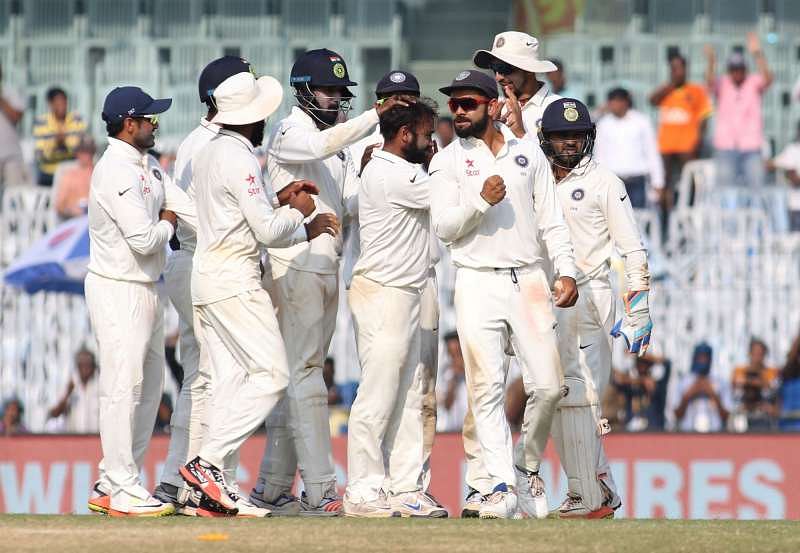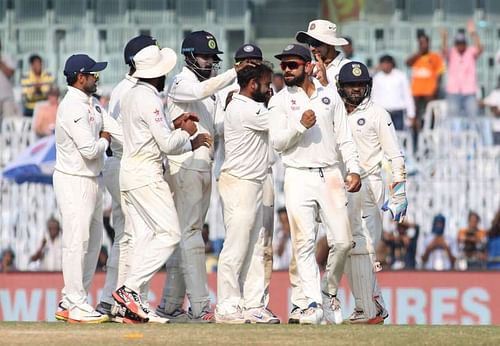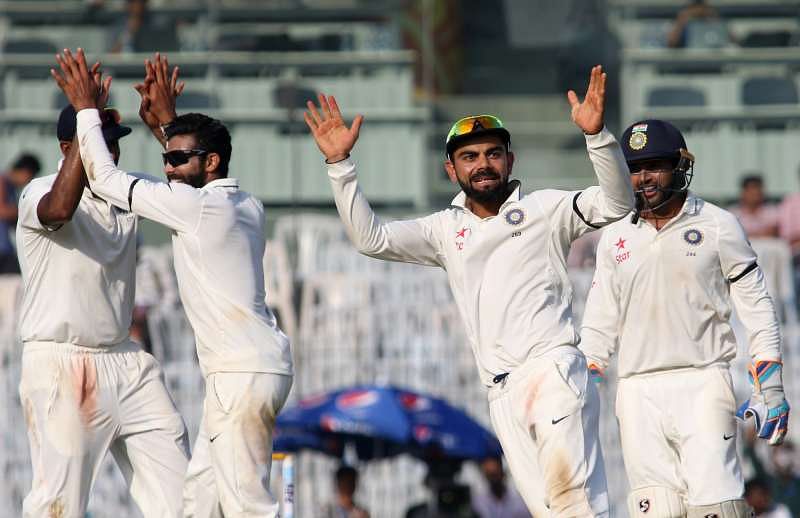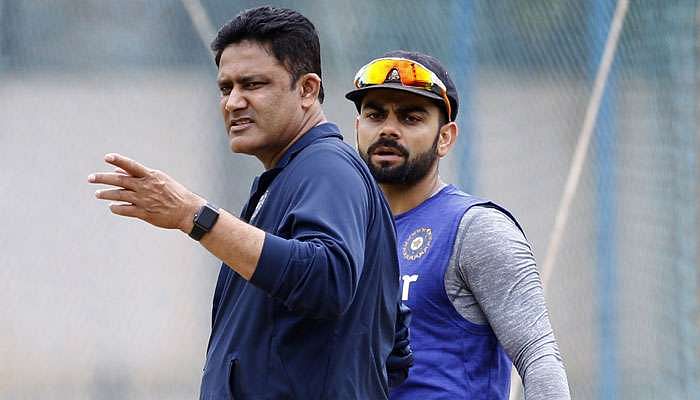
Why India's home victories this season should not be brushed under the carpet

India's obsession with foreign entities is so profound that even in the sport they have consistently excelled in for the better part of the past three decades, they seek foreign pleasures and compare them with the ones had inside their boundaries. Akin to the prospective grooms settled abroad that attract the best of brides, this deep-rooted patronisation and obsession with everything that is offshore has started taking tragic turns.
The intensity and the hard work that goes behind a Test win is reduced to dust when at the post-match press gathering, the home captain is peppered with the questions about the pitch and the rivalry that he shares with an all-rounder in the opposition instead of the performance that he and his men put up on the field.
Also Read: Top 5 Test knocks by Indian batsmen against England since 2006
However, given the 28-year-old lad that Virat Kohli is, the questions are met with an equal if not fierce chiding and the media is made to realize that their duty is to cover the stories, not create them. The captain is right too, in every sense of the word, when he declares that this Indian team can perform on any given wicket and also that his boys focus on being the best that they can be on the field irrespective of the conditions.
Wickets sans ‘rank-turners’
Here are some stats to elucidate just how magnanimous India's last three victories in the Test series have been. England's 477 in the first innings in Chennai was the highest team total in an innings defeat in Test history. India's series-wrapping victory at the MA Chidambaram was the first time that a team had won two consecutive Tests after scoring 400+ runs in the first innings.
The idea of conceding more than 400 runs thrice and then winning by an innings on two of the three occasions would never have sounded to be a feasible one before Kohli and his men made it look easy. That these many runs were scored by a visiting team batting first clearly put the pitch discussion into perspective, something that had robbed the Delhi boy's first series at home as captain off its much-deserved charm last year.

None of the pitches produced for the series could be termed as 'rank-turners’ for whatsoever reason. On the contrary, Rajkot and Chennai saw two of the flattest decks produced for a Test in India for quite some time. Yet, to win what looked to be a dead-draw by the end of the fourth day in Chennai, by bowling England out inside two sessions shows the leaps that this team has taken in terms of relentless attack.
With no assistance from the surface whatsoever, it was the discipline exerted by India's own 'sharp shooter’ Ravindra Jadeja mixed with the pressure to save the game, that led to England's demise on the last day of the series. By lunch on Day 5, the visitors had all ten wickets intact, but once the floodgates opened, there was nothing that could stop them.
Batting heroics from the lower-order
While this magical turnaround on a flaccid track speaks about the discipline of this Indian bowling attack, the batting comebacks should receive their own share of the limelight. The quality of the opposition that India had to overcome was clear when during the Rajkot Test the hosts had to bat the last day out to save the game.
Hence, when India found themselves at 307/6, still 93 runs behind England during the first innings in Mumbai, a special effort was needed. Kevin Pietersen had done that in 2012-13, and Andrew Strauss had done it in 2006, at the same venue. It was about time that an Indian stepped up and claimed the bragging rights at the Indian 'mecca’ of cricket.
Who else would have been more suited to the role than the man carrying the torch of India's newly-found vigour on his shoulders? Kohli's 235 and an unknown Jayant Yadav's maiden Test hundred (104) meant that India roared from a precarious 307/6 to a magnanimous 631, which was 36 more than England's capabilities in the second innings.
The 237-run stand for the 8th wicket, not only batted the English out of the game but also showed the ability to handle the pressure that someone like Yadav, who was only 1-Test-old at the time, possessed. While Kohli's double was indeed a spectacle, it was Yadav's innings that portrayed the true strength of the domestic circuit in the country.
That a youngster stepped up when it was needed the most was obvious when two of his senior pros had done the same in the previous Test – the first that Yadav had played – in Mohali. In reply to England's 283 in the first innings (yes, another toss lost) India found themselves at 204/6, having lost each of their top six batsmen.
Kohli's was the sixth wicket to fall and the Indian tail that had wagged preposterously over the past few Test matches or so was put to test again. India's Nos 7 to 9 had garnered 312 runs at an average of 52 in the three-match Test series against New Zealand at home, and 305 runs at 30.50 in the Caribbean across four Tests.
In this series, they put on 704 runs at 41.41 and contributed largely to the team’s tally of 3135. Ravichandran Ashwin and Ravindra Jadeja scored a large chunk of those runs, as they did in Mohali when they put together a match-defining stand of 97 runs.
Yadav, thereafter, helped Jadeja bat aggressively and score runs quickly, as the two of them stitched together an 80-run stand for the 8th wicket. The top-scorer in the innings before Ashwin, Jadeja and Yadav had batted was Kohli, with his 62. Thereafter, two of the aforementioned three outscored the Indian captain, and Jadeja almost reached his maiden Test hundred.
Time to give the credit that's due
The best part about this victory has been the fact that whenever the team has required a rescue effort, someone has lead the way, quintessentially. This Indian team took the pitch out of the equation, in testing situations, and proved that their efforts cannot be attributed only to the turners put in place (basically, because there weren't any).
The comprehensive performances that have been shown by the Indian cricket team this season have come through the sheer hard work put in by the players, and guidance provided by the experienced duo of Anil Kumble and Rahul Dravid at the senior and junior levels, respectively.
Therefore, attributing these victories to anything but the players' own capabilities will be an admonition, if not a sin, and we, the followers of the sport, as well as the media, must stand up and take note of it.
Winning away from home is definitely a requisite criterion if you want to be a champion side, but what is often brushed under the carpet is the essence of the home wins. After all, what good would the away victories be if you fail to win at home? Would you be considered a champion if you only win away from home? Is home-dominance, without the alleged advantage of 'turners' not a milestone in itself?
These questions must be pondered over while assessing the quality of this Indian side, and the stats presented and the performances shown by the team, as elaborated in this piece should be borne in mind before brushing these wins under the carpet, saying that 'India win only at home.'
Winning at home is not a such a bad thing. In fact, it is not a bad thing at all. Also, it is not something that goes without saying. Winning a Test match, anywhere in the world is tough and teams that do it should be rewarded with laurels and not accusations.
